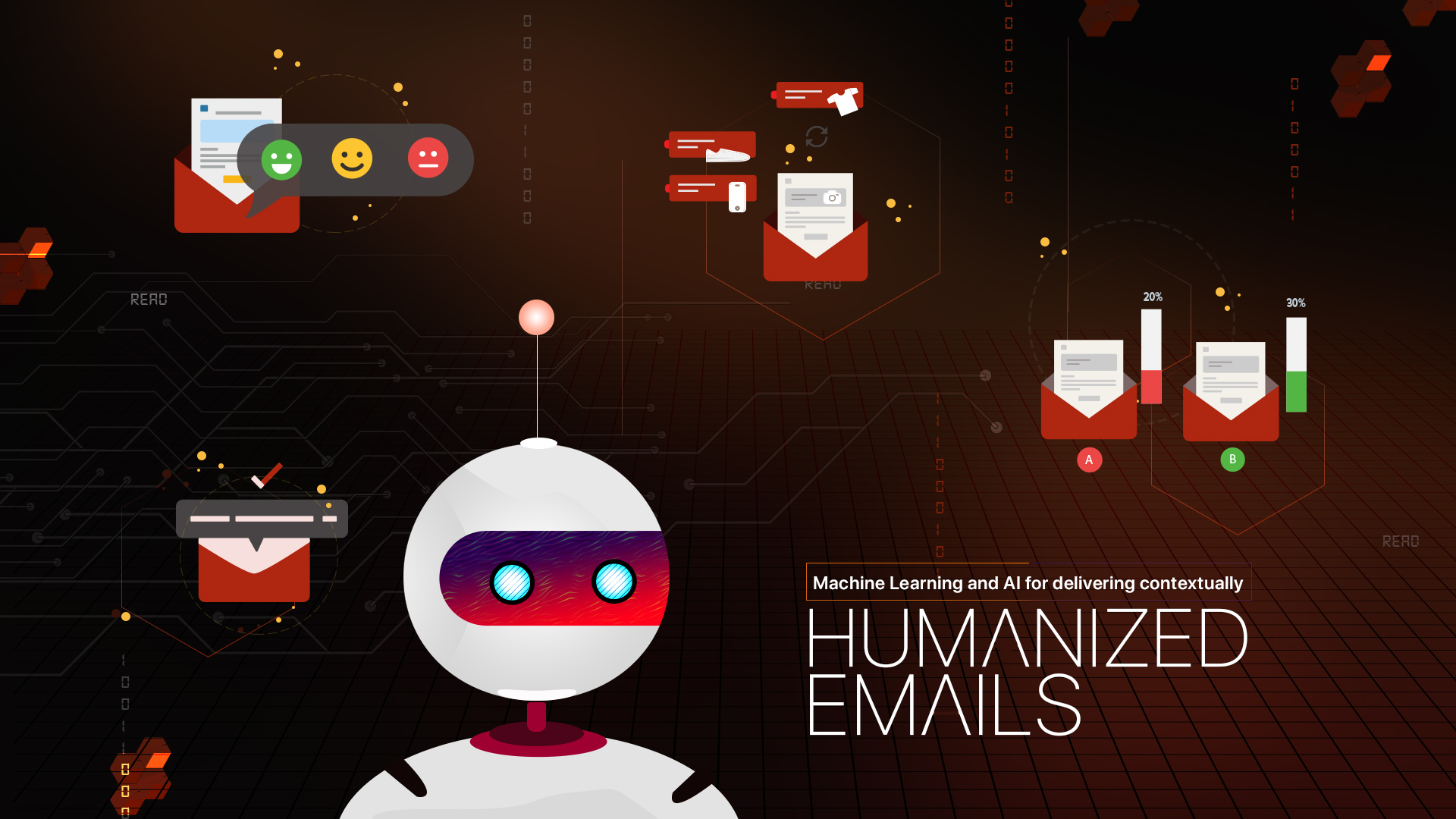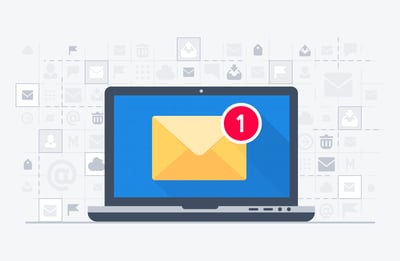July 31, 2019
 by Aishwarya Ashok / July 31, 2019
by Aishwarya Ashok / July 31, 2019

Personalization isn't a new term in email marketing — we've heard a lot about it from time to time.
In today's marketing world, personalization has transformed itself into what's called humanization — something that goes beyond just tailoring emails with a person's name.
Today's buyers want more relevance, experience, and action with every brand's email they receive. So humanized emails don't just address a reader with cursory details like name or gender — they also take into account their specific information like interests and opinions, purchase decisions, likeliness of opening an email, reading capacity, and more.
Machine learning (ML) and artificial intelligence (AI) have shown their power in marketing for a couple of years, and they now strongly influence email marketing as well. While the technology behind these are advanced, they still reassure marketers about the basics: when to send emails, what to enclose in the emails, and whom to send the emails to. If the when-what-whom loop is fixed, most of the challenges in email marketing will be resolved.
| Tip: Check out our resource on reinforcement learning and how it works. |
The good news is that ML and AI helps empower an email marketer to break these challenges and deliver the most sophisticated emails of this digital era—the humanly-mechanized contextual emails.
Here's a walk-through of what email marketers can expect out of machine learning and artificial intelligence now and in the near future.
Designing one-to-one email campaigns, especially when you have to send them in bulk, calls for a lot of effort and thought. From crafting actionable subject lines to optimizing email performance, technology leaves us at no dearth of possibilities.
Times have changed. The debate of whether AI can process as well as humans has been put to rest. People have finally started to understand the indispensable human need for proper functioning of the AI tools. The most recent functionality making waves is AI-powered subject lines for email campaigns.
Natural language processing (NLP) has enabled systems to comprehend, process, and analyze large amounts of human-generated, unstructured data, and convert it into a structured format. Natural language generation (NLG) on the other hand interprets NLP's structured data to generate its own data.
Since the NLP mechanism captures the tone, sentiment, and subject of your brand's email content, the auto-generated subject lines will be aligned with brand identity and voice. In addition, ML also helps optimize subject lines with performance-prediction metrics, letting you create subject lines with the right number of words for inbox displays and increasing open rates.
One of the prime aims of email marketers is to increase open rates while sending emails that resonate better with readers. Contextual emails strike a balance between what your brand has to say and what your subscribers are interested in hearing.
Dynamic content techniques will help you target subscribers at a level that's relevant to them based on their demographics and psychographics, as well as behavioral data like interests, actions, past preferences, geo-location, active times, and so on.
Basically, it's the same HTML that's rendered in each recipient's inbox but in a way they want to see it. ML conveniently helps marketers pick relevant sections that work for specific audiences so a single email campaign can be optimized for effective performance and humanized importance.
Similar to the subject line generation, the same NLP mechanism can help you decode and monitor your email recipients' sentiments. Managing recipients' responses has been made completely automatic with ML. Every element, whether polarity, subject, or the opinion holder's information, is taken into consideration.
Recipient responses can also be a mix of subjectivity and objectivity. While subjective words describe the emotions and sentiments of the recipients, objective ones usually describe something factual.
For example, if a recipient responds to a brand's email stating, "I'm sorry, the demo for Product A was bad!", the response has a subjectivity classification with negative polarity because it describes a bad experience the person had while attending a product demo. Similarly, a response that states, "This software has good features. Thank you!" has an objectivity classification with positive polarity because the person stated a fact that the software has good features.
ML, with the help of its large data sets and specific algorithms, can help marketers conveniently classify the sentiments of email responses within minutes so they can understand the end email receivers' opinions better. Humanized, isn't it?
Testing emails for performance is a common practice in email marketing. With advancements in technology, testing methods are increasingly becoming more modernized, precise, and clever. While A/B testing is the most common tool — one that splits an email into two versions, runs an experiment to find which of the two performs well, and sends the winning version to the majority non-experimental audience — other forms are evolving now.
Multivariate testing creates multiple versions of an email to optimize email performance, while multi-attribute testing simultaneously runs the test for various email attributes like subject lines, content, design, sender address, and so on, to see which one is impactful in bringing more opens, clicks, or both.
Another form that's quite popular is the multi-arm bandit testing, a complex version of A/B testing that uses ML to automatically allocate more mailing list recipients to the version that performs well in terms of the metric such as open rate or click rate and less recipients to the version that underperforms. Each of these testing methods shows the different approaches an email marketer can take to simplify a campaign's performance outcome.
|
TIP: Discover the latest A/B testing software to help you make decisions about optimizing your performance. |
If designing email campaigns is a prime story plot, getting people to actually open and read the emails arriving in their inbox is a different story altogether.
Marketers who send emails periodically definitely agree about the advantages of segmentation, a common method of grouping audiences into different sections based on some conditions or criteria. This method was fairly easy when information was static and structuralized, but with recent data surges, brands and the email marketers representing them face the need to perform automatic segmentation of audiences based on a wide range of pre-defined criteria — response, engagement, behavior, expenditure, purchases, and so on.
ML uses the potential of cluster modeling, the unsupervised learning algorithm that automatically helps segment the audience by drawing inferences or characteristics from existing datasets. Just pick a criteria and watch multiple segments deftly form within your mailing lists.
| TIP: Learn more about supervised vs unsupervised learning. |
Another area interesting marketers is propensity modeling, a predictive algorithm that analyzes existing audience data to predict future behavior — for example, how likely your subscribers are to open your emails, buy your products/services, or what type of emails they tend to open or click.
Sending humanized emails is not only related to curating content that's hyper-personalized for your target audience — it's also dependent upon how to make them read what you've sent. The best solution that ML has provided is a predictive time algorithm that determines the optimal open time for every recipient.
The idea behind this is simple: there's no one-time-fits-all approach, so ML allows you to trigger emails at the exact time a reader would want to see it. This definitely takes into account a recipient's past active or engaging time with respect to email opens and clicks as well as their likeliness to engage further.
Some marketers believe their emails have to stand out on the top fold of recipient inboxes to get a reader's attention quickly — the typical LIFO mechanism by which a queue or inventory accounting works. Send time optimization helps here by algorithmically delivering your emails in the prime time that a recipient sees their inbox.
|
TIP: Curious how machine learning software can help you can help you humanize your emails? Discover the highest-rated options on the market today! |
Today's marketers don't just concentrate on what and when to send, but also on how to send. This depends on the frequency of email sending and knowing how to achieve the right balance of engaging without overwhelming and underperforming. Email cadence helps determine this by defining the email-sending pattern for your brand.
A throttle on the number of emails a brand sends plays a major role in building the audience's interest and trust. While one subscriber might feel like opening every email you send, there's another who wants to unsubscribe because they feel you're spamming them. Just as with finding the optimal time, ML helps you figure out the frequency of email sending for each recipient so they receive as much of a humanized, spam-free email experience as possible.
ML doesn't just help in an email marketer's journey, it also helps the audience as well. Within each of your recipient's inbox, special algorithms help mark emails as spam. So apart from detecting spammy content, these ML-driven filters also separate the spam emails into a folder.
ML and AI contribute a lot to sending humanized, contextual emails that drive better sales. In addition to simplifying the email marketing process, these technologies can also help you perform smart and intelligent marketing that stays abreast of ever-changing times.
Want to keep learning? Discover our AI Hub with over 50 resources to keep you in the path toward knowledge!
Aishwarya is a Product Marketer at Zoho Campaigns, the email marketing platform from Zoho’s business suite. She is a techno-futurist and has a passion for driving marketing through technological humanism. She loves writing as much as painting, and certainly wishes to retire on one of those seascapes she paints.
When it comes to email marketing, subject lines are an introduction to the offer that follows.
 by Angela Ash
by Angela Ash
Marketers often wonder why their emails frequently get sent to spam.
 by Angela Ash
by Angela Ash
Are you getting maximum utility out of your email marketing efforts?
 by Jonathan Herrick
by Jonathan Herrick
When it comes to email marketing, subject lines are an introduction to the offer that follows.
 by Angela Ash
by Angela Ash
Marketers often wonder why their emails frequently get sent to spam.
 by Angela Ash
by Angela Ash


